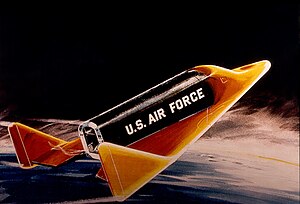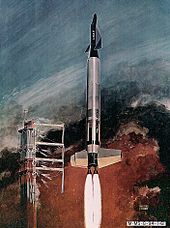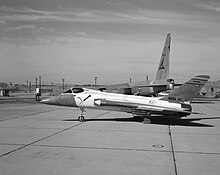Dyna-Soar
| Dyna-Soar | |
|---|---|
 Drawing of the X-20 on re-entry |
|
| Type: | Space glider |
| Design country: | |
| Manufacturer: |
Boeing |
| Commissioning: |
Development aborted |
| Production time: |
Was never produced |
| Number of pieces: |
0 |

Dyna-Soar (derived from English dynamic soaring , dynamic gliding flight, pronounced like dinosaur , dinosaur) was a project of the US Air Force (USAF) with the aim of developing a space glider that could be used as a reconnaissance aircraft and bomber as well as for rescue operations , Satellite or space station maintenance or expansion and sabotage of enemy satellites could have been used. The missile, also known as the X-20 , was 10.77 meters long and 6.34 meters wide and was supposed to have a crew of one man. A Titan III was intended as a launch vehicle for orbital flights . The launcher was supposed to transport the spacecraft to a height of 160 km.
history
The project began in 1957 with the merging of previous research, among others at Bell Aircraft Corporation , where Walter Dornberger worked, who had proposed the concept as early as 1952 and it had been pursued under the name BOMI or ROBO (Rocket Bomber). In mid-June 1958, the Air Force announced the contract with Boeing and Lockheed Martin , as well as funding of around $ 150 million for the first prototype. From November 1958, NASA also participated in the development.
The planning of the test flights in 1960 initially provided for high-altitude drops from B-52 bombers. According to this, five unmanned sub-orbital flights should have taken place, followed by eleven manned flights, in which sensors, navigation, but also rendezvous systems would have been tested for the time being, followed by further military systems and a satellite inspection. The program should be carried out in three stages, a rescue glider (Dyna-Soar I), a reconnaissance glider (Dyna-Soar II) and a strategic bomber (Dyna-Soar III). The first gliding flights for Dyna-Soar I should be carried out in 1963, the strategic bomber Dyna-Soar III should be fully functional in 1974.
Until 1961, the Air Force claimed leadership of the American space program. Up until this point in time, however, she moved away from the planned stationing of weapons in 1958, and in 1962 the US Congress spoke of improved cooperation with NASA and the peaceful use of space, for which President Eisenhower had already spoken out in 1958; a use as a bomber had already fallen out of the ranks at that time.
From February 1962 there was a reorientation away from an operational system to an experimental program and the program was officially renamed X-20. The problem of the previously not really defined (military) mission also shifted to a size problem, as the dimensions for supplying a space station seemed very tight. The question arose more and more whether the money was being spent properly. On September 20, 1962, the Air Force's annual report emphasized the cooperation with NASA (as in Project X-15) and the research focus, away from a specifically military potential. In September 1963, novel materials and alloys were tested in a re-entry test.
The project was ended in 1963 after it had cost 660 million US dollars, as all space capacities were to be merged in the lunar landing program or the preparatory Gemini program . The results of the program were incorporated into the space shuttle program in the 1970s . For its part, the US Air Force began work on the Manned Orbiting Laboratory (MOL).
Astronauts
A total of eight astronauts were earmarked for the X-20 project.
- Neil A. Armstrong (NASA) 1960–62, tested a rescue procedure with a Douglas Skylancer from NASA during the launch phase.
- Albert H. Crews, Jr. (Air Force) 1962-63
- William H. Dana (NASA) 1960-62
- Henry C. Gordon (Air Force) 1960-63
- William John Knight (Air Force) 1960–63
- Russell L. Rogers (Air Force) 1960-63
- Milton O. Thompson (NASA) 1960-63
- James W. Wood (Air Force) 1960-63
Armstrong moved to the NASA astronaut program, crews to the MOL project, and Dana, Knight and Thompson to the X-15 project.
Scheduled Dyna Soar I flights
- Dyna-Soar 1 - January 1966, unmanned
- Dyna-Soar 2 - April 1966, unmanned
- Dyna-Soar 3 - July 1966, 1 orbit, 1 astronaut: James Wood
- Dyna-Soar 4 - October 1966, 1 orbit, 1 astronaut
- Dyna-Soar 5 - March 1967, 1 orbit, 1 astronaut
- Dyna-Soar 6 - May 1967, 1 orbit, 1 astronaut
- Dyna-Soar 7 - July 1967, 1 orbit, 1 astronaut
- Dyna-Soar 8 - September 1967, 1 orbit, 1 astronaut
- Dyna-Soar 9 - December 1967, multiple orbits of the earth, 1 astronaut
- Dyna-Soar 10 - March 1968, several earth orbits, 1 astronaut
See also
literature
- Robert Godwin (Ed.): Dyna-Soar: Hypersonic Strategic Weapons System. Apogee Books, Burlington (Ontario) 2003, ISBN 1-896522-95-5 .
Web links
- Transonic aerodynamic characteristics of the Dyna-Soar glider and Titan 3 launch vehicle configuration with various fin arrangements . (PDF; 2.2 MB) NASA report, April 1963 (English)
- American X-Vehicles: An Inventory X-1 to X-50 . (PDF; 1.1 MB) NASA, SP-2000-4531, June 2003 (English)
- Promotional film Dyna-Soar 1962
Individual evidence
- ↑ a b Amy Shira Teitel: The space plane that wasn't: everything you never needed to know about Dyna-Soar. In: Popular Science. June 22, 2015.
- ↑ Sean N. Kalic: US Presidents and the Militarization of Space, 1946-1967 , Volume 19 of Centennial of Flight Series, Texas A&M University Press, 2012, ISBN 978-1-60344-691-4 , p. 73 ".. .could be used for "reconnaissance, rescue, satellite ispector, bomber and ferry" missions. "
- ^ The X-Planes - X-1 to X-45. Jay Miler Midland pp. 230-239. ISBN 1-85780-109-1
- ↑ Roy F. Houchin II: US Hypersonic Research and Development: The Rise and Fall of 'Dyna-Soar', 1944-1963. (= Space Power and Politics ). Routledge Publishing, 2006, ISBN 0-415-36281-4 , p. 69.
- ↑ Roy F. Houchin II: US Hypersonic Research and Development: The Rise and Fall of 'Dyna-Soar', 1944-1963. (= Space Power and Politics ). Routledge Publishing, 2006, ISBN 0-415-36281-4 , p. 49.
- ↑ Bell manned skip-glide space bomber project of the early 1950's. Predecessor to Dynasoar. , astronautix.com, accessed March 8, 2020
- ↑ American plans for a spacecraft , NZZ , June 19, 1958.
- ^ Exploring the Unknown - Selected Documents in the History of the US Civil Space Program, Volume IV: Accessing Space , NASA, 1999, therein: Ray A. Williamson: “Developing the Space Shuttle”, p. 163
- ^ Curtis Peebles; High Frontier: The US Air Force and the Military Space Program , DIANE Publishing, 1997, ISBN 978-0-7881-4800-2 , page 18
- ↑ Sean N. Kalic: US Presidents and the Militarization of Space, 1946–1967 , Volume 19 of Centennial of Flight Series, Texas A&M University Press, 2012, ISBN 978-1-60344-691-4 , p. 70 ". .substantially backed away from its 1958 position of arming the heavens ... "
- ↑ Sean N. Kalic: US Presidents and the Militarization of Space, 1946-1967 , Volume 19 of Centennial of Flight Series, Texas A&M University Press, 2012, ISBN 978-1-60344-691-4 , p. 71 ".. .to insure the peaceful uses of space "
- ^ Curtis Peebles; High Frontier: The US Air Force and the Military Space Program , DIANE Publishing, 1997, ISBN 978-0-7881-4800-2 , page 19 ff
- ↑ Sean N. Kalic: US Presidents and the Militarization of Space, 1946-1967 , Volume 19 of Centennial of Flight Series, Texas A&M University Press, 2012, ISBN 978-1-60344-691-4 , p. 74 ". .X-20 does not represent a vehicle for a specific military job. "
- ^ Roger D. Launius, Dennis R. Jenkins: Coming Home: Reentry and Recovery from Space , National Aeronautics and Space Administration, Government Printing Office, 2012, ISBN 9780160910647 , p. 140


